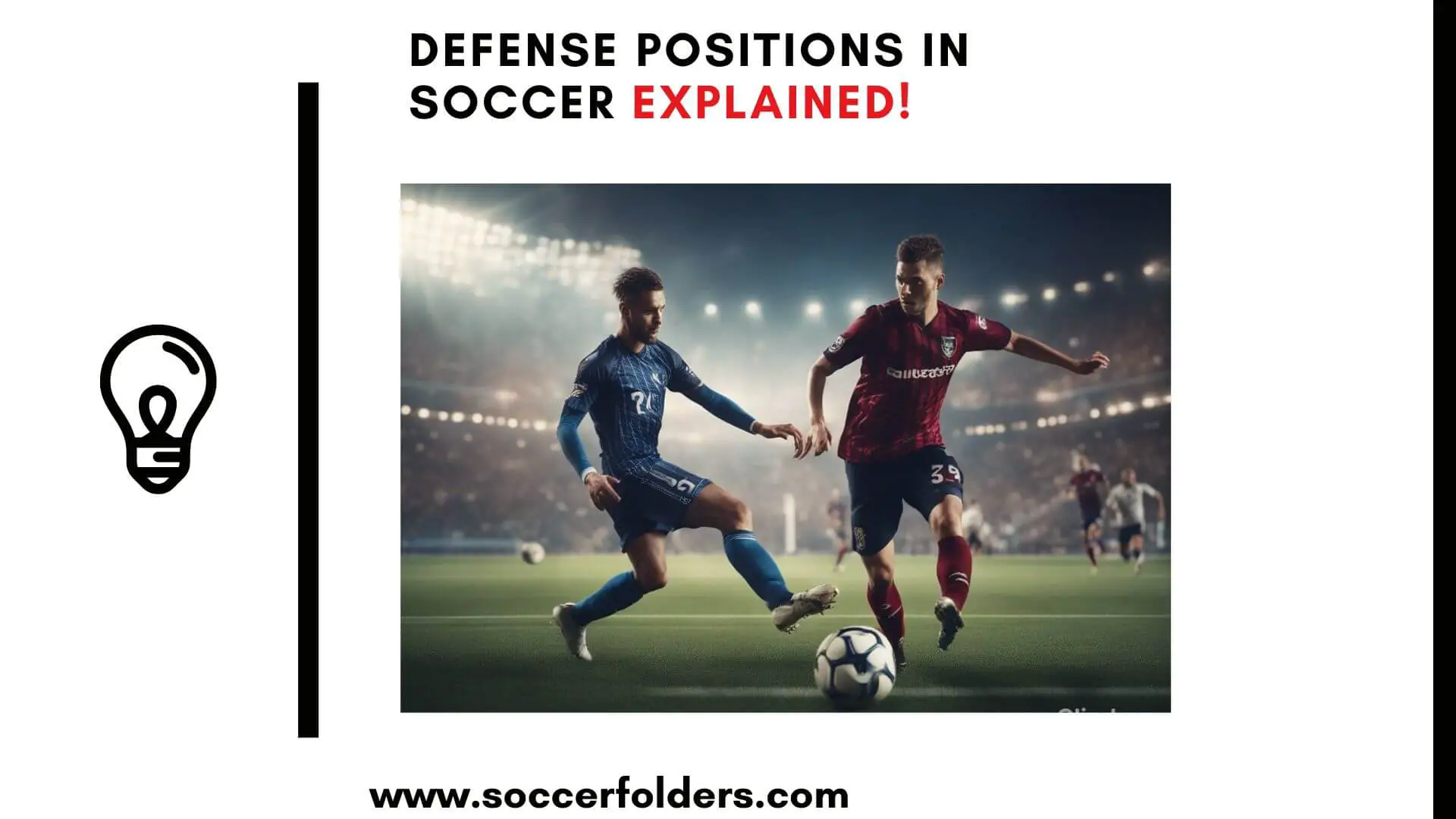In the beautiful game of soccer, defense positions play a pivotal role in determining the outcome of matches. The art of defending is often overshadowed by the flair of attackers and goal-scoring heroes, but a solid defense is the foundation upon which championship teams are built.
I am here to provide you with a comprehensive guide on defense positions in soccer, combining strategic tactics and personal insights to help you up your game on the field.
Without further ado, let’s jump right in.
Table Of Contents
- What is a Defense Position in Soccer?
- Defensive Drills and Training: Building a Solid Backline
- Zone vs. Man-to-Man Marking: Finding the Right Balance
- Transition Defense: Reacting Swiftly to Regain Control
- Pressure and Pressing: Applying Coordinated Defensive Force
- Defending Against Counterattacks: Keeping Composure on the Break
- Set-Piece Defense: Winning the Aerial Battles
- Defensive Psychology: Mental Resilience and Focus
- Final Word
What is a Defense Position in Soccer?
A defense position in soccer refers to the role played by players who protect their team’s goal, thwarting opponents’ attacks, and ensuring defensive stability on the field. These players include centre-backs, full-backs, defensive midfielders, and goalkeepers.
1. The Center Back Position: Heart of Defense
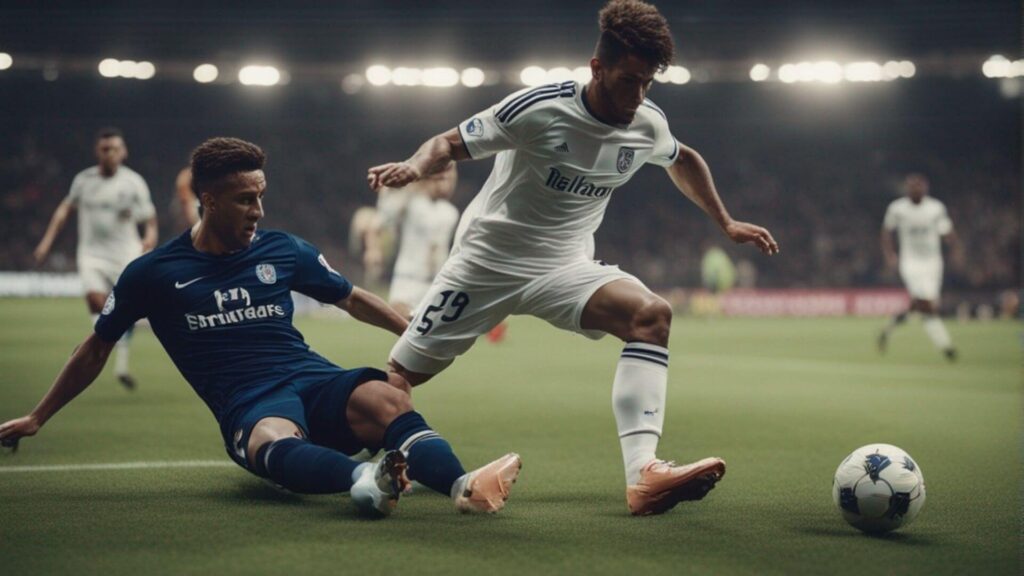
At the heart of any defense lies the center-back position, the wall that stands between attackers and the goal. Center-backs are the anchors of the defense, providing stability and leadership in the backline.
In the heat of the game, center-backs must communicate effectively with their teammates, organizing the defensive shape and directing players into the right positions.
To excel in this position, center-backs must possess impeccable positioning, anticipation, and composure under pressure.
Being a center-back is like being a master chess player, always one step ahead of the opposition’s moves. An excellent example of a center-back is the legendary Italian defender, Franco Baresi, who was renowned for his defensive intelligence and ability to read the game.
Moreover, center-backs need to be dominant in the air to win aerial duels and clear dangerous crosses. Aerial prowess not only helps in defensive situations but can also be an asset during set-piece plays, contributing to offensive opportunities.
Center-backs also play a critical role in launching counterattacks. Upon winning possession, they can initiate quick transitions by making accurate long passes to exploit spaces left behind by the opposition’s attacking players.
This ability to start attacks from the back is becoming increasingly vital in modern soccer.
Read more about the Center back soccer position here.
2. Full-Backs: The Unsung Heroes of Defense
The full-backs are often the unsung heroes of the team, making valuable contributions both in defense and attack.
As someone who also played full-back myself, I understand the thrill of surging forward on the wings to support the offense and the responsibility of tracking back to thwart counterattacks.
Modern full-backs must possess exceptional stamina, pace, and crossing ability. They are the engine on the flanks, overlapping with wingers and whipping in dangerous crosses.
An excellent example of an attacking full-back is Brazil’s Cafu, whose marauding runs down the right flank were a constant threat to the opposition.
However, they must also be mindful of their defensive duties, ensuring they don’t get caught out of position and leaving gaps behind them. Speed and recovery skills are crucial assets for full-backs to cope with fast wingers and support the center-backs during defensive transitions.
Additionally, full-backs are often involved in one-on-one duels with tricky wingers. Patience and timing are key when defending against skilful opponents. Sliding tackles and well-timed interceptions are tools full-backs must utilize to win the ball back safely.
Read more about the Full Back soccer position here.
3. Defensive Midfielders: The Commanders of the Midfield
While center-backs provide the first line of defense, the defensive midfielders act as the commanders of the midfield. As a player who transitioned from a central defender to a defensive midfielder, I found this position uniquely challenging and rewarding.
Defensive midfielders are tasked with breaking up opposition attacks, shielding the defense, and initiating the team’s build-up play. Vision, passing accuracy, and the ability to read the game are essential traits for a successful defensive midfielder.
One exemplary defensive midfielder is Spain’s Sergio Busquets, whose impeccable ball control, spatial awareness, and ability to intercept passes have made him one of the best in the world. Like a skilled puppeteer, Busquets dictates the rhythm of the game from deep positions, orchestrating his team’s movements.
Defensive midfielders act as a crucial link between defense and attack. They receive the ball from the centre-backs, and with a swift turn, distribute it forward to the attacking players. Timing and precision are crucial, as a misplaced pass in this zone could lead to a dangerous counterattack by the opposition.
Moreover, these players must be tenacious in their tackling and possess the mental discipline not to be drawn out of position by attacking players. Their ability to win possession and regain control quickly can disrupt the opposition’s rhythm and create opportunities for their team.
Read more about the defensive midfielder here.
4. Sweeper: The Libero Position – A Defensive Maestro
The sweeper, also known as the libero, is a position that has evolved over the years but remains a timeless testament to the art of defense. The role of the sweeper is to operate as the last line of defense, covering the gaps left by the centre-backs and acting as the team’s defensive playmaker.
The sweeper position was made famous by legendary players like Franz Beckenbauer and Franco Baresi. These players not only excelled in stopping opposition attacks but also showcased their abilities in initiating offensive plays from the back.
The libero is a master of reading the game, possessing the vision to spot potential threats and the tactical intelligence to neutralize them. Their ability to anticipate opponents’ movements allows them to intercept passes and break up attacks even before they materialize.
This position requires exceptional composure under pressure, as the sweeper often operates with limited defensive cover behind them. Making the right decisions and executing them flawlessly is essential to maintain defensive solidity and control the flow of the game.
The sweeper’s unique role as a deep-lying playmaker allows them to start offensive moves and link the defense with the midfield and attack. This role is akin to that of a quarterback in American football, orchestrating the team’s movements and distributing the ball with precision.
In modern soccer, the sweeper position has undergone some changes due to evolving tactical systems. Many teams now opt for a more traditional defensive line, employing an additional defensive midfielder instead of a dedicated sweeper. However, the essence of the sweeper’s qualities remains invaluable to any defense.
Read more about the sweeper positions in soccer here.
5. Goalkeeper: The Last Line of Defense
The goalkeeper is a position that demands nerves of steel and extraordinary reflexes.
A goalkeeper must exude confidence, communicate effectively with the defense, and be ready to make game-changing saves.
Diving acrobatically to deny goal-bound shots and mastering the art of positioning are crucial aspects that define a top-notch goalkeeper.
An excellent example of a world-class goalkeeper is Germany’s Manuel Neuer, who revolutionized the role by integrating sweeping techniques outside the penalty area. Neuer’s bravery and willingness to act as an auxiliary defender has set a new standard for modern goalkeepers.
Goalkeepers must also command their penalty area during set-pieces, organizing the defense and claiming high balls to alleviate pressure.
Timely interventions in one-on-one situations with onrushing attackers are game-changers that can tilt the match in favour of their team.
Defensive Drills and Training: Building a Solid Backline
To build a rock-solid defense, players must engage in specific defensive drills and training sessions. These exercises help hone their defensive instincts, improve decision-making under pressure, and enhance their physical attributes.
One essential drill is the “1v1 defending” exercise, where defenders face attackers in isolated situations. This drill teaches defenders how to stay composed, track the attacker’s movements, and time their tackles to win the ball effectively.
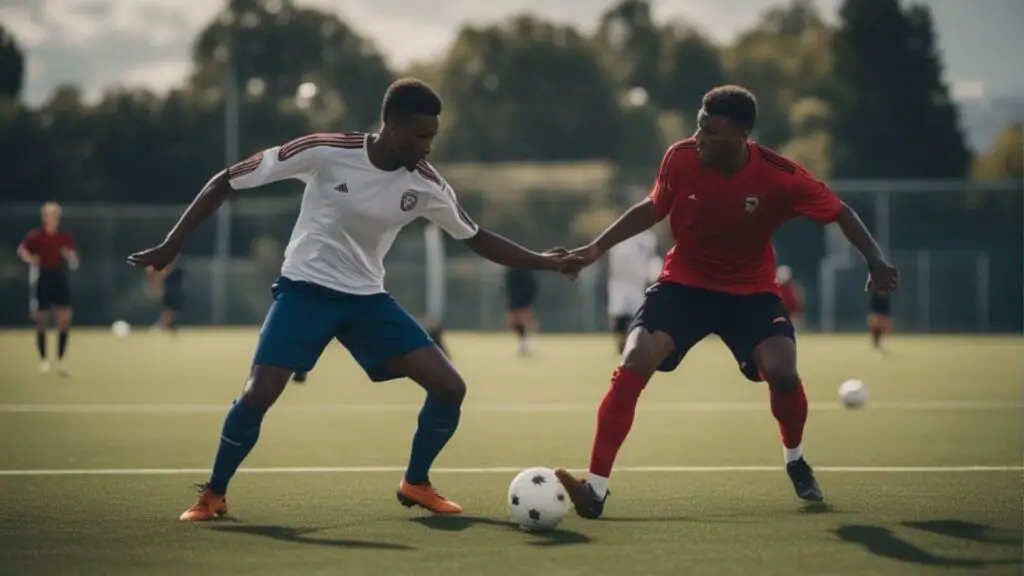
Another critical drill is the “zonal defending” practice. Here, defenders learn to work in unison, marking specific zones rather than individual players. Proper coordination among defenders ensures that gaps are closed and attackers are denied space to exploit.
Moreover, “defensive positioning” drills are essential to teach defenders where to stand in various game scenarios. Understanding the right positions enables defenders to intercept passes, block shots, and prevent attackers from finding dangerous spaces.
Regular fitness training is also crucial for defenders. Exercises to enhance speed, agility, and endurance ensure that they can keep up with fast-paced attackers throughout the match. A fitter defender can recover quicker, close down attackers more effectively, and minimize defensive errors due to fatigue.
Zone vs. Man-to-Man Marking: Finding the Right Balance
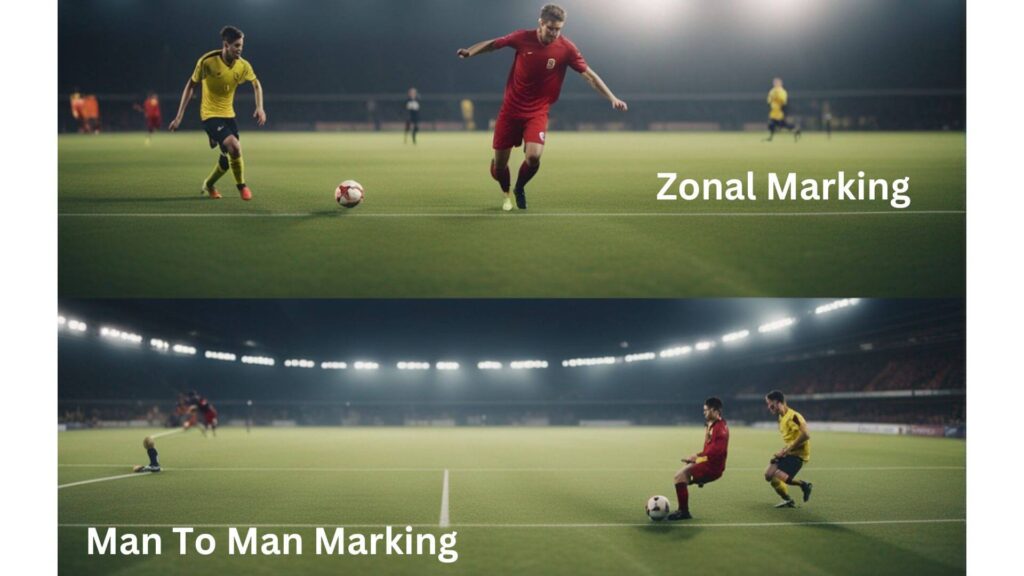
In soccer, teams can adopt either zone defense or man-to-man marking to thwart the opposition’s attacking threats.
Zone defense involves players guarding specific areas of the field rather than sticking to individual attackers. This approach enables defenders to cover more ground collectively and maintain compactness in defense.
On the other hand, man-to-man marking involves defenders sticking closely to specific opponents, following them wherever they go on the field. This strategy aims to deny the opposition time and space, making it challenging for them to create scoring opportunities.
Finding the right balance between these two approaches is crucial.
Teams must be flexible in their defensive tactics, knowing when to use zone marking to close down spaces and cut passing lanes, and when to apply man-to-man marking to nullify the influence of key opposition players.
Transition Defense: Reacting Swiftly to Regain Control
Transition defense is a critical aspect of the game that determines a team’s ability to regain control after losing possession. When possession is lost, defenders must quickly switch from an attacking to a defensive mindset.
One way to strengthen transition defense is through the practice of “defensive transition drills.” These drills simulate different game scenarios, such as losing possession in the attacking third or during a set-piece, and train defenders to react promptly and reposition themselves to prevent counterattacks.
Additionally, effective communication between defenders is vital during transition moments. Players must alert their teammates about potential threats, ensuring everyone is aware of their defensive duties and marking responsibilities.
Pressure and Pressing: Applying Coordinated Defensive Force
Pressure and pressing are high-intensity defensive strategies used to force the opposition into making mistakes and regain possession in advanced areas of the field.
In “high-pressure situations,” defenders apply intense pressure on the ball carrier and nearby players. This tactic aims to force hurried passes or turnovers, disrupting the opponent’s build-up play and creating opportunities for quick counterattacks.
Pressing, on the other hand, involves a coordinated effort from the entire team to squeeze the opposition into a compact space. Defenders work together to cut off passing lanes, giving attackers limited options and making it easier to regain possession.
Defending Against Counterattacks: Keeping Composure on the Break
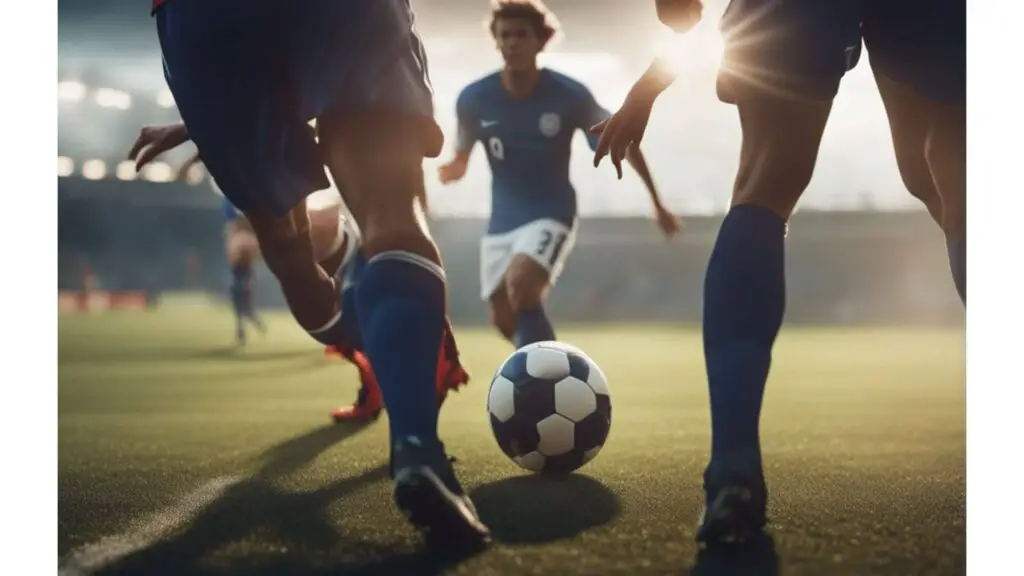
Defending against counterattacks requires defenders to remain calm and composed, even when the opposition rapidly transitions from defense to attack.
A well-drilled defensive line can avoid being caught off-guard during counterattacks. Defenders should maintain a suitable defensive shape and track the movement of attacking players, preventing them from exploiting spaces left behind.
To counter counterattacks effectively, defenders should prioritize slowing down the opposition’s progress rather than diving into tackles recklessly. By delaying attackers, defenders can buy time for their teammates to track back and assist in regaining possession.
Also read: How to defend in soccer?
Set-Piece Defense: Winning the Aerial Battles
Set-piece defense is crucial in preventing the opposition from capitalizing on dead-ball situations, such as corners, free-kicks, and throw-ins.
Defenders should focus on zonal marking during set pieces. Assigning specific players to mark specific areas ensures that each defensive zone is covered, reducing the risk of unmarked attackers getting free headers.
Height and aerial ability are essential attributes for defenders when defending set pieces. By winning aerial battles, defenders can clear dangerous balls and deny opponents scoring opportunities.
In addition to zonal marking, teams should practice set-piece routines to improve offensive and defensive coordination during such situations.
Well-rehearsed set-piece plays can lead to goals, while solid set-piece defense prevents conceding in these situations.
Also read: How to defend a corner kick?
Defensive Psychology: Mental Resilience and Focus
Defensive psychology plays a significant role in a defender’s performance on the field. Mental resilience and focus are critical traits that defenders must develop to stay sharp and composed throughout the game.
Staying focused means avoiding distractions and maintaining full concentration on the game. As a defender, you must be alert to read the opposition’s moves and anticipate their next actions.
Moreover, you should have the mental resilience to bounce back from mistakes. Soccer demands fast reflexes, but even skilled defenders err.
Use mistakes to grow, keep positive, and quickly regain focus to prevent further distractions.
Positive communication among defenders is also crucial for building team morale and cohesion. Encouraging and supporting each other on the field fosters a sense of unity and motivation, boosting overall defensive performance.
Final Word
Mastering the defense positions in soccer requires a blend of tactical awareness, physical abilities, and mental fortitude.
Whether you are a player aspiring to improve your skills or a soccer/football enthusiast keen on understanding the details or complexities of the game, this guide has provided valuable insights into the critical roles defenders play on the field.
Remember, defense is not just about individual skills but a collective effort to protect the team’s goal.
By incorporating these strategies and tactics, defenders can become the formidable shield that anchors their team’s success on the soccer pitch.
You can also read this guide to understand all soccer positions.

